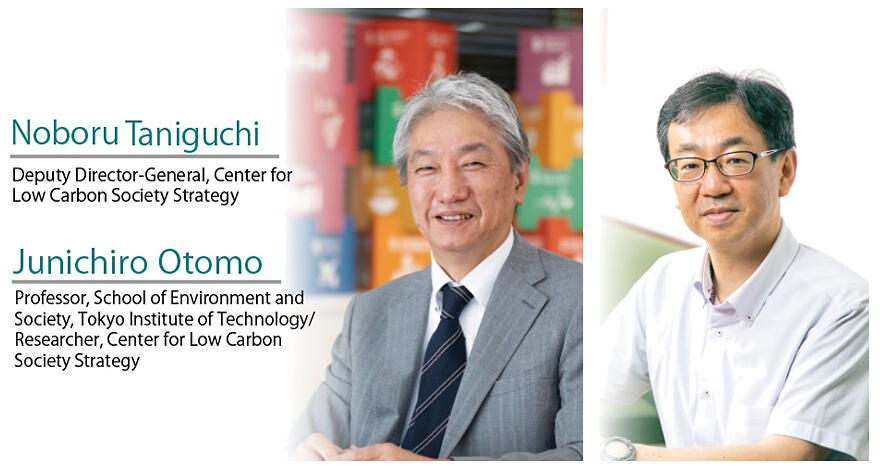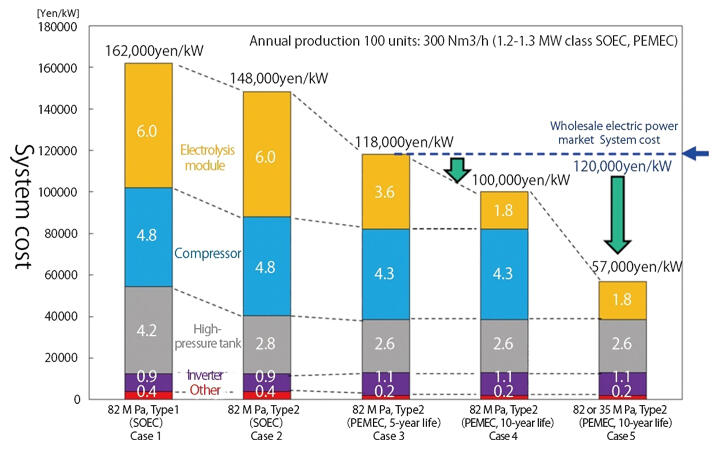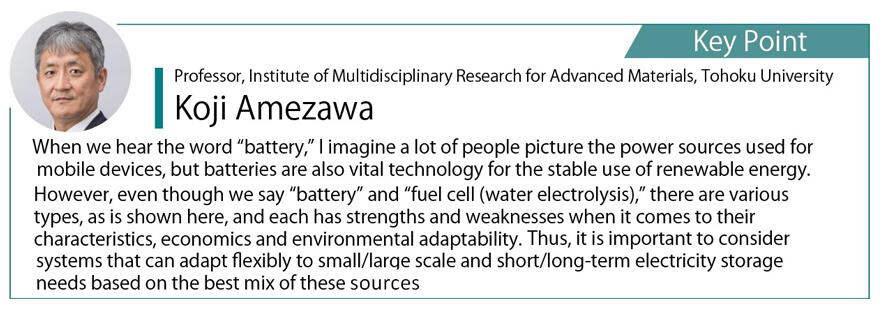
This is the sixth installment in a series of stories in which Yutaka Minakawa, a young employee of a trading company, reads and analyzes proposal papers by the Center for Low Carbon Society Strategy (LCS). In the last installment, Minagawa learned about pumped-storage power generation as a technology for storing energy that is indispensable to the creation of an electric power structure for 2050. In this installment, he asked LCS Deputy Director-General Noboru Taniguchi and LCS researcher Junichiro Otomo about the current technologies related to storage batteries and hydrogen, which, together with pumped storage hydropower, are vital to decarbonization through renewable energy, and about their future prospects.
Technology is used differently depending on its purpose and goal
Working toward reducing costs and the environmental burden
Minagawa: Today, I've come to ask about storage batteries and the use of hydrogen. Thanks for talking to me. First, can you tell me about the current status of storage batteries?
Taniguchi: There are several different varieties of storage battery depending on the electrolyte and cathode/anode material combination. For example, computers use lithium-ion batteries (LIB). The development of storage batteries includes lead acid batteries, nickel-hydrogen (Ni-H) batteries and LIB, and batteries with high energy density depending on their purpose. With increasing demand for the latest mobile equipment, the development of LIB has advanced rapidly (Table 1). Now, the spotlight is on research with a focus on the popularization of electric vehicles (EV), including solid-state batteries with greater capacity, longer life, increased safety, and that do not ignite easily.
Table 1: Comparison of the performance of various rechargable batteries

Minagawa: Looking at the table, at the moment LIB cost more than other storage batteries, so I'm concerned about electricity costs if these are introduced.
Taniguchi: The key to fixing this is making sure the most suitable battery is used for each purpose. LIB will likely continue developing for use as portable power sources, such as for EVs and cell phones. But when it comes to establishing electricity storage facilities adjacent to renewable energy power generation plants, for example, the size and weight aren't so important. I think lead storage batteries are suitable for places that have leeway for space and load capacity. Their structure is relatively simple, and lead as a material is inexpensive, so the costs can be kept down. Lead Acid batteries can also curb CO2 emissions to a quarter of that of LIB.
Minagawa: Lead storage batteries have been used as automobile batteries for a long time - they're not new, right?
Taniguchi: It's because they've been used for a long time that we can say they're easy to introduce. Also, the manufacturing technology is well established, and laws for their production, use, disposal, and recycling are already in place. Recycling lead could enable a sustainable supply of reproduced storage batteries in Japan. This will surely be useful for large-scale electricity storage facilities in the future.
Using hydrogen, suited to long-term storage - Large-scale demonstration experiments in Fukushima Prefecture
Minagawa: If we consider the efficiency and cost of batteries on the assumption that renewable energy is going to be popularized, the latest technology is not necessarily the best, then.
Taniguchi: Batteries have always been developed in accordance with their end-use. The most suitable battery changes depending on that end-use, so when it comes to large-capacity electricity storage, sodium-sulfur batteries (NaS) and redox flow batteries (FR) are also useful. Based on trial calculations, if these have large capacities, the initial costs are reduced, and a profit can be made. Therefore, if a demand for large capacity appears and an installation environment is arranged, the merits of these replacing lead storage batteries and LIB will become apparent. When it comes to LIB, the focus is also on iron phosphate LIB, which doesn't use expensive cobalt or nickel for electrodes.
Minagawa: If their development progresses, we'll come closer to "bright and affluent zero emissions."
Taniguchi: If the cost of electricity is too high, they won't develop as an industry, however much they are able to reduce CO2. We are compiling financial numbers such as battery durability and production costs to estimate a cost-minimum electrical power structure for 2050 as we meet the goal of decarbonization, so we can propose the best and optimal scenarios for the Japanese economy and for the environment. More specifically, one of LCS' roles is to indicate that we should consider renewable energy power generation and electricity storage together as our future direction.
Minagawa: It seems like it would work just with storage batteries - why are you including the use of hydrogen in your scenarios?
Otomo: I'll explain that. Hydrogen's strengths include long-term storage and mobility. For example, storing hydrogen created by solar power generation in the summer so it can be used in winter, or using hydrogen stored overseas in Japan. If we consider this long-term storage and mobility, technology that makes renewable energy take the form of hydrogen and stores it will be useful for reducing costs.
Minagawa: What do you mean by storing renewable energy in the form of hydrogen?
Otomo: The ideal would be using electricity generated through renewable energy to create hydrogen through the electrolysis of water in fuel cells, then when this is used again as electricity, making use of it to generate power through fuel cells and/or making it into fuel for thermal energy generation using hydrogen turbines.
Minagawa: How much progress has been made in fuel cell development?
Otomo: Currently, demonstration experiments are being carried out in Fukushima Prefecture, testing a hydrogen supply facility that carries out large-scale electrolysis using alkaline electrolyte fuel cells. The next stage is the promotion of research and development that will increase safety and power generation efficiency through large-scale water electrolysis systems that use polymer electrolyte fuel cell (PEFC), which are used in fuel cell hydrogen automobiles, and after that, furthering the development of a solid oxide electrolysis cell (SOEC), which uses solid oxide fuel cells (SOFC).
Minagawa: What are the differences between PEFC and SOFC?
Otomo: The environments that they work best in are different. The operating temperature of PEFC is around 80℃ or lower, and they are easy to start and stop, so they can realize their potential even when operated for short periods. They are suited to flexible work, such as operating only when there is a large surplus of energy from solar power generation due to very fine weather. On the other hand, SOFC work at a high temperature of up to 700℃ and are inefficient when used for short periods of time. They display higher efficiency than PEFC when operated consistently for long periods of time. If the individual elements that make up fuel cell systems can be improved in both types, we have calculated that their costs will decrease further, and by combining power generation and electrolysis, their use in the current wholesale electricity market will be more than just a dream (Figure 1).
Figure 1: The road to technological innovation and cost reduction

The future beyond zero emissions
Recovering CO2 for chemicals and fuels
Otomo: The key to ensuring the low cost of hydrogen is to reduce the cost of the electric power used in hydrogen creation and find out how to make the process of creating hydrogen using electrolysis (which uses the most energy) more efficient. We must create materials that use hydrogen as a new energy carrier in society at the same time as engaging in technological development with an eye to the future.
Both the cost of generating renewable energy and the cost of hydrogen production mean that we won't suddenly be introducing the ideal method we spoke about earlier - the key to popularizing this is to first broaden supply and usage methods and establish a market for hydrogen. The proposal we are putting forward is to first import cheap hydrogen created from large-scale renewable energy generation overseas and use it to reduce CO2 emissions from energy generation via dual combustion - mixing the hydrogen with fossil fuels when generating thermal energy - or to carry the hydrogen by transforming it into ammonia, which can be transported at normal temperatures, and use it as fuel in this form.
Minagawa: The strength of a trading company is the ability to look at the supply chain as a whole and make a total profit.
Otomo: That's promising. In my lab at the Tokyo Institute of Technology, I am also focusing on training human resources who can engage in research and development with a broader perspective that looks at the whole, from designing materials to estimating costs for social implementation. Our talk today looked to around 2050, but if we promote a variety of technological development and reduce costs, in the far future we may be able to recover CO2 that has been emitted and make it react with hydrogen, creating chemicals and fuels that are used in everyday life.
Taniguchi: Japan has potential for renewable energy, with sunlight, wind power and geothermal energy in different regions. In the future, if we can establish facilities across Japan with sets of renewable energy power generation and storage technologies that make the most of local characteristics and promote local energy production for local consumption, we'll be able to create a society with peace of mind from the perspective of security, as well as carbon neutrality.
Minagawa: I now understand that LCS' scenarios consider both the economy and the environmental burden, and I have higher hopes for the future. Dr. Taniguchi, Dr. Otomo, thank you very much.
* This is a fictional narrative based on an interview.
(TEXT: Asami Takahashi; PHOTO: Hideki Ishihara, Seiko Kusu)





